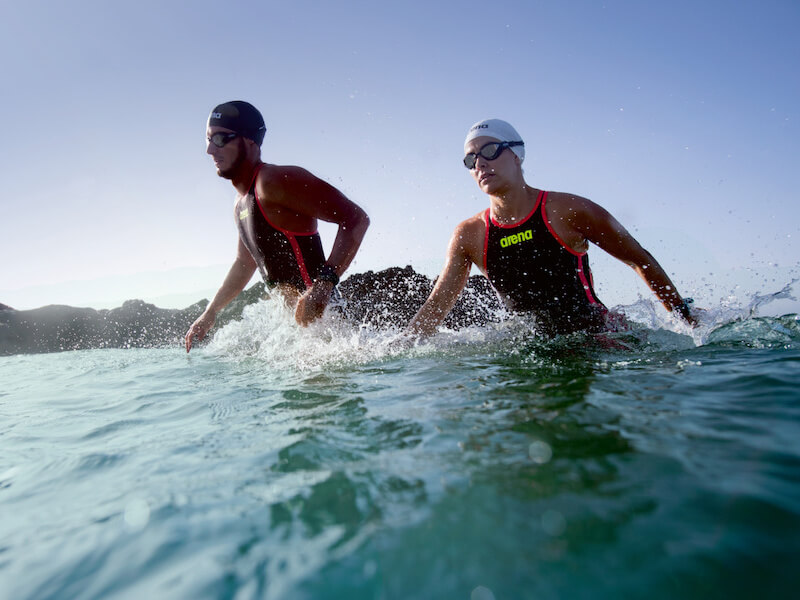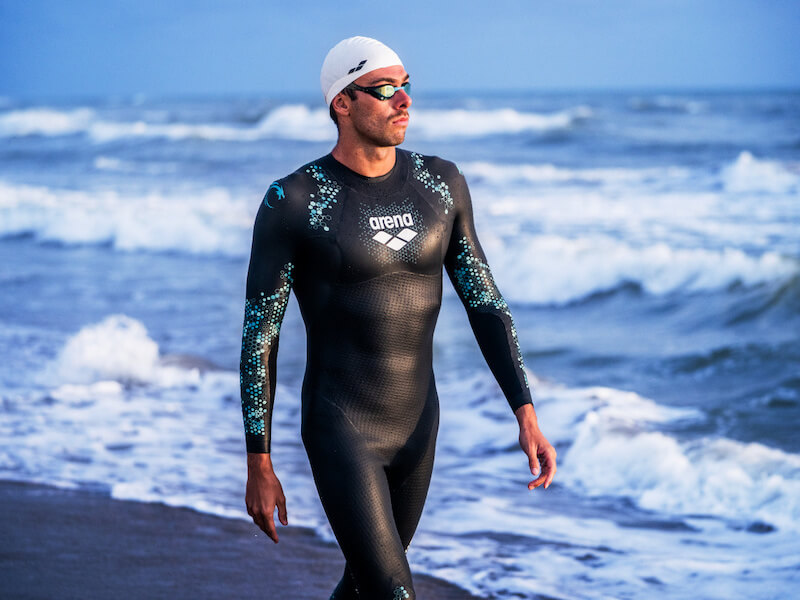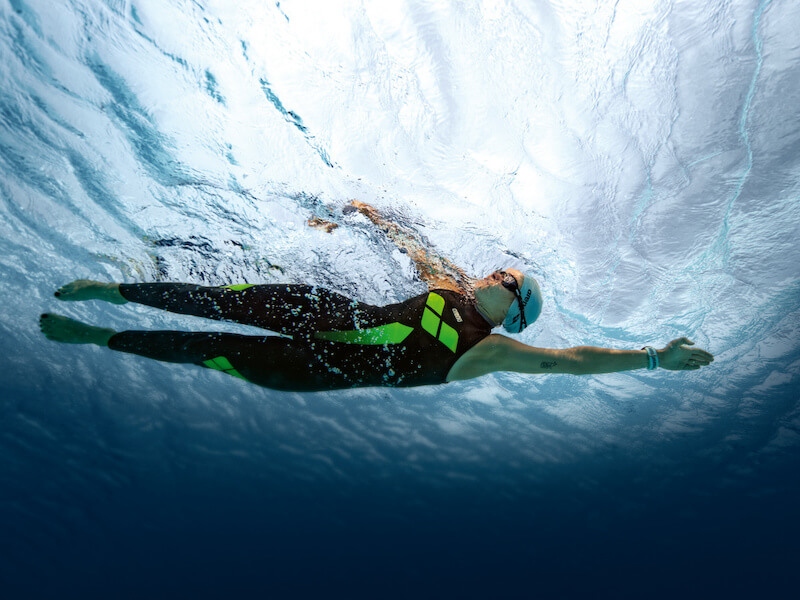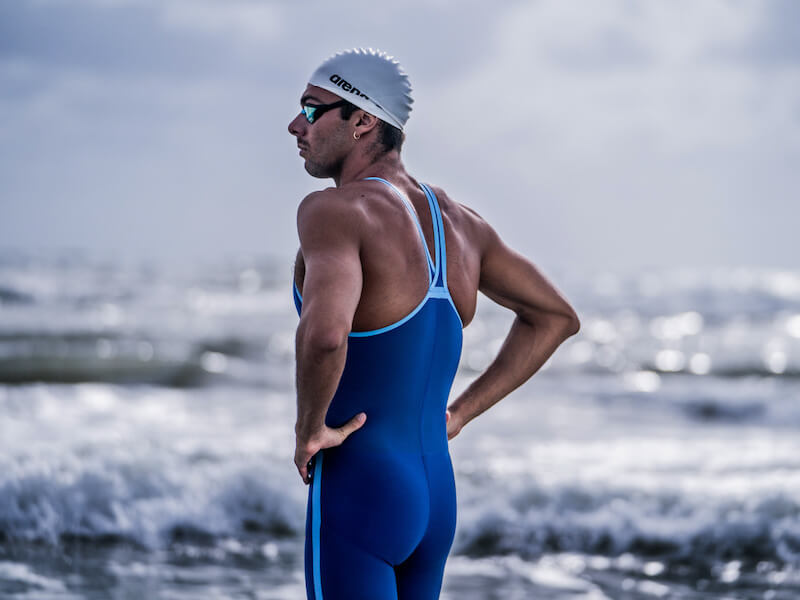Safety Tips and an Open-Water Swimming Workout for Speed Endurance
Open-water swimming workouts are no longer just for those training for triathlons or a select few who get a thrill from cold-water immersion. Open water swimmers are now becoming a regular sighting in lakes and rivers all year round.
In this article, we’ll offer a basic introduction to the forever-evolving world of open-water swimming. First, we will look at some simple steps you can take to stay safe as well as some useful equipment to use during your open-water swimming. Finally, we will give you an open-water swimming workout that will definitely raise your heart rate and improve your speed endurance.
How to Stay Safe When You’re Open-Water Swimming

The first time you enter a local lake or reservoir, you’ll soon realize it’s a lot different from pool swimming. First, there may not be a lifeguard, and second, the temperature isn’t regulated. Without these comforts and more, it’s important that you pay attention to your safety and that of others around you.
Research the Body of Water
Make sure to Google the water you’re swimming in. Swimming could be prohibited in that area due to boating and other hobbies. There’s also a risk that a reservoir’s water could be lying on top of mined materials that give off radiation. Still, bodies of water are usually safer than rivers, but if you insist on swimming in a river, check the weather, and be mindful of water hazards.
Take note of locations of weirs, which are changes in the height of the river level. Weirs cause a recirculation that is impossible to escape. Strainers are another danger, such as trees or nets. They let water through but not solid objects and can cause you to be pinned in strong currents.
Never Swim Alone
For many of us, swimming is a hobby of purposeful solitude. The idea of swimming alone in a lake that’s two hours away from civilization sounds like bliss. However, even with all the right safety equipment, you never know when you may suffer from a terrible cramp or even an unexpected health emergency.
Stick to the Edge
Many people are attracted to the extremely low water temperature of winter open-water swimming workouts. But cold water can lead to impaired use of your limbs, confusion and even hypothermia. If the cold water becomes too much, it will be a long way back if you were completing a “length” of the body of water. For this reason, always swim around the circumference of the water (whether it’s winter or summer). That way if you get into trouble, you’re closer to the shore.
Be Mindful of Time
When you’re swimming in open water (cold water especially), always swim with a waterproof watch so that you know how long you’ve been in the water. You should always base your swims on past experience, only adding extra time gradually if you feel yourself getting more accustomed.
After a certain amount of time in low water temperatures, your body may start to feel very warm. Be wary of this pleasant experience as it can lead to a false sense of security. When you exit the water, you will always cool down more and really begin to feel the effects of the cold.
Essential Equipment for Open-Water Swims

You should never go for an open-water swim without the following equipment, whether alone or in a group. The safety measures that we take for granted when pool swimming are not usually present in open water.
Tow Float
This is the most important piece of additional equipment, aside from your swimwear or wetsuit. A tow float may cause the teeniest amount of drag, but it protects you in two very important ways. They tend to be made out of a high-visibility material, so other swimmers and hikers are aware of your location. If you get into trouble, it’s something to hold on to until your rescue.
A good tow float may also have a whistle and an incorporated dry bag that you can put your valuables in.
Skin Insulation
When swimming in open water, it’s not essential to wear anything, as it’s all up to the individual. Just be aware that everywhere can get cold. That means you may need a swim hat, ear plugs, wetsuit or a triathlon suit. There’s also neoprene gloves and socks out there, as a lot of people find those areas exceptionally cold due to circulation issues.
Covering up can also offer added protection for your skin when you come into contact with solid objects. Barnacle-encrusted rocks can scrape the skin when getting out of the water, and there may be sharp rocks or litter underfoot.
When getting out of the water after a colder swim, a towel and warm clothing will be helpful. But, if you can spend the extra cash on a dry robe, you can start to warm up a lot quicker as your freezing cold hands might struggle to zip and button fiddly clothing.
Sports Watch
As we mentioned earlier, you should keep an eye on the time with a sports watch when you’re open-water swimming. But if you can afford a watch that lets you know the temperature, this will make your swim a lot safer as you track progress and safety margins. Many adventure/sports watches will also let you save your swims and track your progress with other built-in safety features, such as mapping.
A cheaper option is of course to just get a basic waterproof watch and a traditional mercury thermometer.
Try This Open-Water Swimming Workout

If you thought training for open-water distances meant simply swimming kilometer after kilometer, then you were wrong. An extremely important aspect, not to be underrated, is speed endurance training.
That is because there are moments in a race, regardless of whether the race is over 3 kilometers (km), 5 km or even further, when you need to handle sudden changes in pace.
Not to mention the end of the race, when the person with the fastest sprint and best “legs” will easily beat the other competitors.
So, even though you might think this is a workout for sprinters, bear in mind that it is mainly designed for long-distance athletes.
1. Warm-Up
- 400 meters (m) at an easy pace
- 2 x 50m legs with a 20-second recovery
- 100m sculling
- 4 x 50m legs with snorkel and no kickboard with a 20-second recovery
- 100m hypoxic set with a 3/7 breathing pattern by 50m. This means you breathe on every third stroke for the first 50m, then breathe every seventh stroke for the second 50m.
We have decided to include some legwork so that swimmers do not overlook this aspect, even though you only use your legs at the beginning and end of a long-distance race.
2. Main Set
- 8 x 50m freestyle (the first 25m with your head out of the water and the second 25m at an easy pace). Use a 1.5-minute send-off time for each 50m rep. That means the longer you take to swim the 50m, the less rest you will have between reps.
- 100m at an easy pace
- 4 x 50m (alternate between 50m at high speed with control and 50m at an easier pace, breathing every five arm strokes). Use a 1.5-minute send-off time for each 50m rep.
- 100m at an easy pace
- 9 x 100m (perform the following three reps and then repeat the sequence two more times: 75m fast plus 25m at an easy pace, 50m as hard as you can plus 50m at an easy pace, and 25m without breathing plus 75m at an easy pace). Use a 2.5-minute send-off time for each 100m rep.
The ratio between the hard part and recovery part is 1:2; this will allow you to do the fast parts at the right intensity and recover properly during the slower part.
The high-speed work is aimed at simulating the three parts of a race:
- Swimming freestyle with your head raised simulates the first part of the race and the approach to the directional buoys.
- The hard swim plus slow swim and breathing every five strokes simulates mid-race changes in pace.
- The final changes in pace simulate the end of a race, launching “sprint finishes” from further out (75 m) to much shorter sprint finishes (25 m).
3. Cool Down
- 400m at an easy pace
After completing this workout, you will have swum a total of 3,000 meters.
Get Out There!

You now know that there’s a lot more to think about in regard to safety compared to your usual pool workouts. Whether you’re training for an open-water race, or you just want to enjoy some well-deserved time outdoors, make sure you keep safety in mind and have the right equipment. Think about how to stay afloat if the worst happens, keep warm in cold water, and record time and temperature.
Check out arena for swim training aids and swimwear that will suit your open-water swimming workouts as well as open-water events like ironman triathlons.
Written by:
Thomas Board
Tom is an outdoor and adventure travel writer and full-time firefighter based in Leeds, UK. He spends his free time summiting the mountains of Wales and wild swimming in the lakes of Snowdonia all year round.







